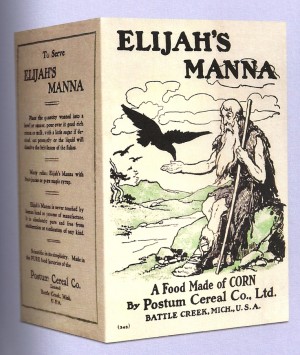Cereal Killers
In the late 1800s, a man named John Harvey Kellogg invented the cereal now known as Corn Flakes, and a few years later, his brother, W.K. Kellogg, popularized the food and a cereal company using the family name. Within a few years, the product became a staple across America — and gave rise to a controversial competitor.
Why? A lot of people thought corn flakes were sacrilegious.
To find out why, we have to revisit the back story to the Kellogg brothers’ corn flakes. That story has been told in these pages before (warning: it’s a lot more PG-13 than you’d think), but to recap an unimportant detail — well, it’s important for the upcoming story, but not all that important for the one just linked — John Harvey Kellogg realized he had a winner on his hands when he served his corn flake invention to the patients at the sanitarium he ran. Unfortunately for the brothers Kellogg, one of the patients in the sanitarium was a man named C.W Post. Post decided to start his own cereal company, the not-so-creatively-named Postum (now “Post”) Cereal Company. In 1904, two years before the similarly not-so-creatively-named Kellogg’s Company introduced its corn flakes to the world, Post beat them to the punch.
But as any American consumer of corn flakes knows, it’s Kellogg’s flakes which are the well-known brand; Post’s are virtually unheard of. That’s because shortly after C.W. Post introduced his corn flake cereal to consumers, he found himself on the wrong end of a holy war. Why? Let’s look at what Post’s corn flakes looked like — the packaging that is — back over 100 years ago.

Yes, he called it “Elijah’s Manna,” a reference to the Old Testament prophet and heaven-sent food referenced in the Bible. And, according to the book “American Empress: The Life and Times of Marjorie Merriweather Post” (Ms. Post was C.W. Post’s daughter), the name and box art went over very, very poorly:
In pulpits across the country, the clergy denounced C.W.’s packaging, condemning the cereal as a “sacrilege” and an exploitation of the Bible. In Britain a law was even passed banning the import of Elijah’s Manna. As usual, C.W. tried to defend himself in print. “Perhaps no one should eat Angel cake, empty Adams’ Ale, live in St. Paul, nor work for Bethlehem Steel.” But the industrialist’s words were ignored. Somehow, Elijah’s Manna has become a symbol of sacrilege, a contemptuous parody of the sacred wafer and of all things holy.”
Faced with potential customers who were unhappy with the religious imagery Post eventually capitulated. As Mental Floss reports, in 1908, he changed the name of the product to “Post Toasties” — and in the 1930s, replaced Elijah’s image with that of Mickey Mouse. But by then, Kellogg’s had established itself as the go-to brand for corn flakes.
Bonus Fact: According to AM New York, if you see a bowl of cereal in a cereal ad, you probably aren’t seeing it sitting in a bowl of milk: “Oftentimes stylists will use Elmer’s Glue, so the cereal won’t get soggy.”
From the Archives: The Curious History of Graham Crackers and Corn Flakes: It’s amazingly PG-13 — or, maybe R.
Related: “American Empress: The Life and Times of Marjorie Merriweather Post” by Nancy Rubin Stuart. 4.2 stars on 102 reviews.
